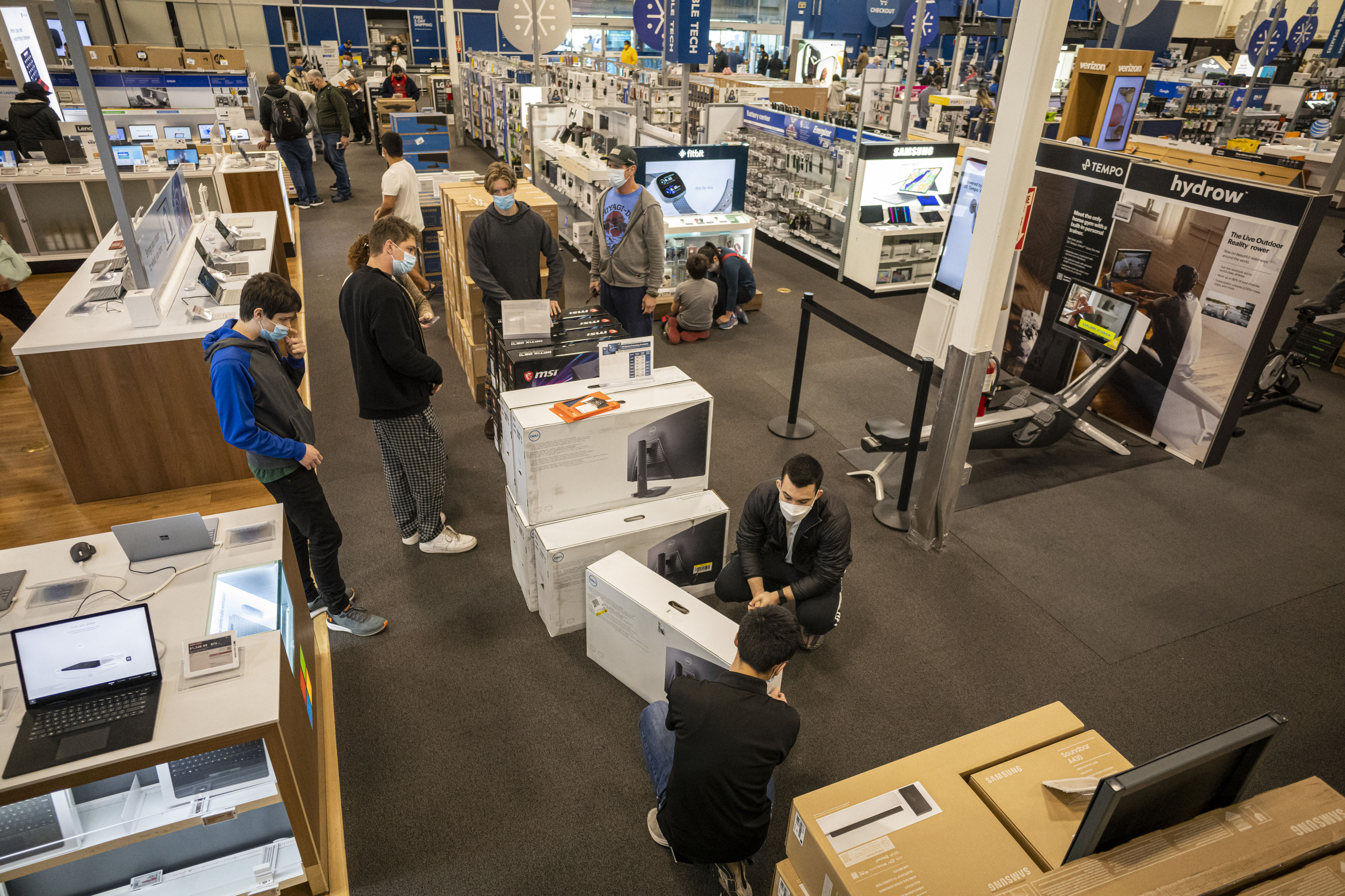
Shoppers wait in line to check out at a Best Buy store on Black Friday in San Carlos, California, U.S., November 26, 2021. /Getty
Shoppers wait in line to check out at a Best Buy store on Black Friday in San Carlos, California, U.S., November 26, 2021. /Getty
Editor's note: Fang Zihao is currently pursuing a PhD at Koç University,Turkey. The article reflects the author's opinions and not necessarily the views of CGTN.
In October, inflation reached 6.2 percent in the U.S., 4.1 percent in the Eurozone and 4.2 percent in the UK. Meanwhile, inflation in China was only 1.5 percent and China's current consumer price level is even lower than it was in January 2020. Also, Japan's inflation rate was only 0.1 percent. Clearly, inflation is not a global phenomenon today.
The main reason for China's low inflation rate is its success in containing the COVID-19 pandemic. On the one hand, the government did not have to keep introducing massive fiscal stimulus or the central bank to toss money out of helicopters to counter unprecedented uncertainty. On the other hand, China's labor force participation rate stayed steady, while the unemployment rate rose only slightly by 1 percent in early 2020 before returning to pre-COVID levels. In this way, and aided by its robust industrial production and modern logistic infrastructure, China has managed to keep inflation low in the face of a global commodity boom.
In the U.S., however, the situation is completely different. Among all factors that contributed to inflation, one of the most important has been the stagnant labor force participation rate as the economy overheats: the inflation rate and wages are soaring and unemployment is already low. This is because many ordinary Americans remain fearful of the pandemic, voting with their feet and refusing to return to work. Worrisomely, the low labor participation rate could potentially lead to a wage-price spiral.
Accordingly, the most immediate way to address inflation is to effectively control the COVID -19 pandemic, which will encourage individuals to come out of their homes and go to work. The U.S. now has powerful tools to contain the virus, including vaccines and drugs. The U.S. should also consider reintroducing successful measures in East Asia, including mass testing, isolation of confirmed and suspected patients and international travelers, and lockdowns of high-risk areas. If the U.S. manages to maintain low death rate, the pandemic-induced inflation will likely fade away in a year.
In the meantime, we may have entered a long-term cycle of rising global inflation.
Over the past four decades, we have witnessed an abiding decline in global inflation, from a high of more than 10 percent per year in the 1970s to less than 3 percent per year in the 2010s. However, the low global inflation environment of the past decade is unlikely to sustain, most notably because the global demographic dividend has passed its peak.
When an economy's dependency ratio (dependents that are aged younger than 14 or over 65, compared with the working-age population) falls, labor supply is plentiful, savings and investment increase, economic output subsequently expands, while the economy's aggregate consumption cannot keep up, leaving consumer prices under deflationary pressure. If it is an open economy, it will accumulate trade surpluses, which are equivalent to providing savings abroad. At the same time, no matter how unreasonably high asset prices have gone, younger generations have no other choice but to purchase the assets so that they can sell them for consumption when they retire.

Shoppers at a Best Buy store on Black Friday in San Carlos, California, U.S., November 26, 2021. /Getty
Shoppers at a Best Buy store on Black Friday in San Carlos, California, U.S., November 26, 2021. /Getty
The global dependency ratio stayed high throughout the 1970s. At the same time, Japan and Europe gradually exhausted their cheap labor and caught up to the U.S. in industrialization. Consequently, global inflation then was easily driven up by wage raises in high-income countries.
Later on, the global dependency fell constantly and reached its all-time low in 2015, as the baby boomers joined the labor force. More importantly, China's transition from a centrally planned economy to a market economy has pushed hundreds of millions of young workers into the global economy. So, the global inflation rate and real interest rate kept declining and valuation multiples in the stock markets kept rising. In a sense, the U.S. capital markets and entrepreneurial ecosystem have also benefited tremendously from the global demographic dividend.
Now as the baby boomers retire, the global dependency ratio has ceased declining and is quietly picking up. China is also aging, while other emerging markets have much lower savings rates. Apart from demographic structure, the savings rate is dependent on the culture and economic institutions. This shift in global demographics will potentially reverse the current trend of inflation in long-term decline.
Furthermore, while global decarbonization will necessitate enormous expenditures in infrastructure and industrial facilities, such renovation and reconstruction are unlikely to boost productivity or reduce costs.
The UN's Intergovernmental Panel on Climate Change (IPCC) estimates that an annual investment of $2.4 trillion is needed in the energy system alone until 2035 to limit temperature rise to below 1.5 degrees Celsius from pre-industrial levels. That need alone eats up more than 10 percent of global annual gross savings. Besides, wind and photovoltaic power are still more expensive than thermal and hydro power in the world's most regions. The energy crises that we are seeing today in many countries are only a prelude to an extremely costly energy transition in the future.
Potentially, global supply chains may be restructured upon governments' requests: multinational companies will more likely vertically integrate their production within regional trading blocs rather than globally; that is, goods may no longer be produced in the most efficient way. This is the polar opposite of what used to happen after China joined the World Trade Organization.
Remember Friedman's pencil? "There's not a single person in the world who could make this pencil." Back in 1980, making a simple pencil already required a coordinated supply chain in North America, Latin America, and ASEAN countries. Today, this trade network has become much more complex and sophisticated than it has ever been. "That is why the operation of the free market is so essential. Not only to promote productive efficiency, but even more to foster harmony and peace among the peoples of the world," he concluded.
Current inflation in the Western countries will likely phase out after the pandemic is brought under control. However, other global challenges, such as demographic shifts and decarbonization, will make for a steady rise in global inflation in the decades to come.
In such a secular economic gloom, the last thing all mankind needs is decoupling and tensions between major countries. Only through inclusive multilateral cooperation can we address our common challenges and create a shared future for all.
(If you want to contribute and have specific expertise, please contact us at opinions@cgtn.com.)

